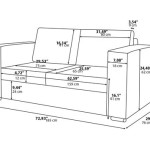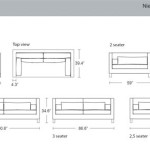How Does A Sofa Bed Mechanism Work?
Sofa beds provide convenient sleeping arrangements by transforming from a comfortable sofa into a functional bed. This transformation is made possible by an internal mechanism, cleverly designed for ease of use and durability. Understanding how these mechanisms work can be helpful when choosing a sofa bed and for troubleshooting potential problems.
Key Components of a Sofa Bed Mechanism
Several key components work together to facilitate the sofa bed's transformation. These include the frame, the mattress, the folding mechanism, and the support legs.
The frame provides the primary structure and houses the folding mechanism. It's typically made of metal or wood, offering stability and support. The mattress is designed for both sitting and sleeping comfort. The folding mechanism is the heart of the sofa bed, allowing it to shift between its two forms. Finally, the support legs provide stability when the bed is extended.
Common Types of Sofa Bed Mechanisms
Several different types of mechanisms are commonly used in sofa beds, each with its own advantages and disadvantages. Three of the most popular mechanisms are the pull-out, the click-clack, and the futon mechanisms.
Pull-Out Mechanism (also known as Bi-Fold or Fold-Out)
This mechanism is arguably the most common and traditionally recognized. The bed frame and mattress are folded and stored underneath the sofa cushions. To convert the sofa into a bed, the user pulls the frame forward, unfolding the mattress in a bi-fold motion. Supportive legs typically extend automatically or manually lock into place.
Click-Clack Mechanism
Click-clack mechanisms are known for their simplicity and ease of use. The back of the sofa is hinged and can be lowered to create a flat sleeping surface. The name “click-clack” comes from the audible clicks heard as the mechanism locks into the sofa and bed positions. This mechanism is often found in more compact sofa beds.
Futon Mechanism
Futon sofa beds utilize a simpler design than pull-out or click-clack models. The sofa's back simply folds down to create a flat sleeping surface. Futons are often known for their firm sleeping surface and minimalist aesthetic.
Detailed Explanation of the Pull-Out Mechanism
The pull-out mechanism, due to its widespread use, warrants a more detailed explanation. Its functionality relies on a series of interconnected metal bars, hinges, and springs.
The metal frame, containing the folded mattress, rests on a wheeled track system hidden within the sofa frame. Pulling on a fabric handle or strap attached to the frame initiates the unfolding process. The track system allows the frame to glide smoothly forward.
As the frame is pulled out, the bi-fold mattress begins to unfold. Supporting legs, often attached to the frame's underside, automatically extend or are manually locked into place to provide stability. Once fully extended, the mattress lies flat, forming the bed.
Detailed Explanation of the Click-Clack Mechanism
The click-clack mechanism operates on a simple hinge and locking system. The sofa back is attached to the frame by a hinged mechanism that allows it to be lowered.
To convert the sofa into a bed, the user pushes the back of the sofa backward until they hear a click, indicating the mechanism has unlocked. The back is then lowered until it rests horizontally, creating a flat sleeping surface alongside the seat cushions. Another click signifies that the mechanism has locked into the bed position.
Detailed Explanation of the Futon Mechanism
The futon mechanism is characterized by its simplicity. The sofa back is essentially hinged to the seat frame, allowing it to be folded down.
To transition from sofa to bed, the user simply pushes the back of the sofa downwards until it rests flush with the seat cushions, forming a flat sleeping surface. Some futon mechanisms include a locking feature to secure the back in the bed position.
Maintaining Sofa Bed Mechanisms
Regular maintenance can extend the life of a sofa bed mechanism. This includes keeping the mechanism clean and free of debris, lubricating moving parts periodically, and checking for any signs of wear and tear.
Vacuuming around and under the mechanism helps prevent dust buildup that can interfere with smooth operation. Applying a silicone-based lubricant to hinges and moving parts helps reduce friction and prevents squeaking. Regularly inspecting the frame, hinges, and support legs for signs of damage can help prevent more serious problems down the road.
Troubleshooting Common Issues
Occasionally, sofa bed mechanisms may encounter problems. Common issues include difficulty opening or closing the mechanism, squeaking noises, and broken or bent parts. Many of these issues can be resolved with simple troubleshooting steps.
If the mechanism is difficult to operate, check for any obstructions that may be blocking the movement of the frame or mattress. Lubricating the moving parts can often resolve squeaking noises. If a part is broken or bent, it may need to be repaired or replaced. Consulting the manufacturer’s instructions or seeking professional help is recommended for more complex issues.

Understanding Sofa Bed Mechanism Types Made To Last Blog

Understanding Sofa Bed Mechanism Types Made To Last Blog

Understanding Sofa Bed Mechanism Types Made To Last Blog

Understanding Sofa Bed Mechanism Types Made To Last Blog

Folding Sofa Bed Mechanisms Transformable Mechanism Manufacturer

Sofa Sleeper Mechanisms From Leggett Platt Home Furniture

Folding Sofa Bed Mechanisms Transformable Mechanism Manufacturer

With This Mechanism Hardware You Can Hide The Sofa Bed Frame Under Your If Wanna Turn Into Diy Design

Understanding Sofa Bed Mechanism Types Made To Last Blog

Understanding Sofa Bed Mechanism Types Made To Last Blog








